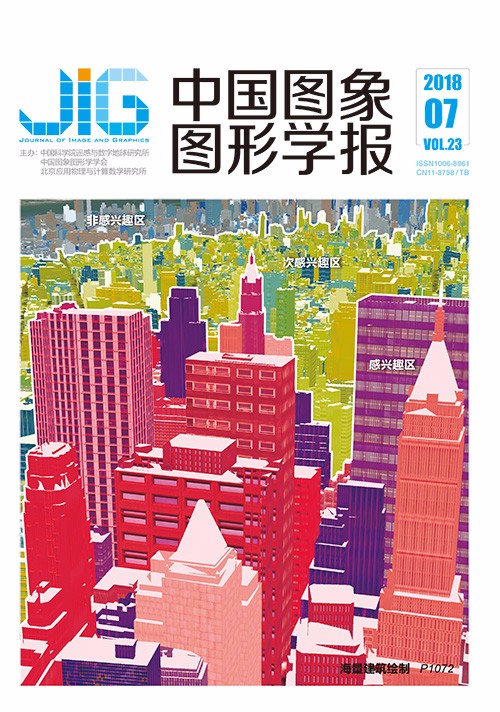
增强成对旋转不变的共生扩展局部二值模式
摘 要
目的 针对成对旋转不变的共生局部二值模式(PRICoLBP)算法对图像光照、旋转变化鲁棒性较差,且存在特征维度过大的问题,提出了一种可融合多种局部纹理结构信息的有效特征——增强成对旋转不变的共生扩展局部二值模式。方法 首先,对图像各像素点的邻域像素点灰度值进行二值量化得到二值编码序列,并不断旋转二值序列得到以不同邻域点作为编码起始点对应的LBP值;然后,分别利用极大、极小LBP值对应的邻域起始编码点和中心像素点确定两个方向矢量,并沿这两个方向矢量在两个不同尺度图像上选取上下文共生点;其次,利用扩展局部二值模式(ELBP)算法的旋转不变均匀描述子来提取上下文共生点对的中心像素灰度级、邻域像素灰度级及径向灰度差异特征间的相关性信息;最后,用上下文共生点对的特征直方图训练卡方核支持向量机,检测纹理图像类别。结果 通过对Brodatz、Outex (TC10、TC12)、Outex (TC14)、CUReT、KTH-TIPS和UIUC纹理库的分类实验,改进算法的识别率比原始的PRICoLBP算法识别率分别提高了0.32%、0.57%、5.62%、3.34%、2.1%、4.75%。结论 利用像素点LBP特征极值对应的起始编码序列来选取上下共生点对,并用ELBP算法提取共生点对局部纹理信息,故本文方法能更好描述共生点对间的高阶曲率信息及更多局部纹理信息。在具光照、旋转变化的Outex、CUReT、KTH-TIPS纹理库图像分类实验中,所提方法比原始PRICoLBP算法取得了更高的识别率。实验结果表明,改进算法相比于原始算法能在较低的特征维度下对图像光照、旋转变化具有较好的鲁棒性。
关键词
Enhanced pairwise rotation-invariant co-occurrence extended local binary pattern
Gao Pan1, Liu Guangshuai1, Ma Ziheng1, Yu Yafeng2(1.School of Mechanical Engineering, Southwest Jiaotong University., Chengdu 610031, China;2.China Aviation Optical-Electrical Technology Co, Ltd, Luoyang 471003, China) Abstract
Objective As effective local texture descriptors, local binary pattern (LBP) and its variants are widely applied in various fields of image processing. As an LBP variant, the pairwise rotation invariant co-occurrence LBP (PRICoLBP) algorithm classifies texture better than other LBP variant algorithms do by extracting high-order curvature and contextual co-occurrence information between spatial context co-occurrence pixel points. However, PRICoLBP determines these points by using the pixel gray gradient vector, which changes with image rotation and describes the image texture by using the co-occurrence histogram between the original LBP and uniform LBP (LBPu2) features of the context co-occurrence pixels. Consequently, the PRICoLBP algorithm has poor robustness to variations in image illumination and rotation and has high computing feature dimensionality. An efficient texture feature named enhanced pairwise rotation-invariant co-occurrence extended LBP (ELBP), which can fuse a variety of local texture structure information, is proposed in this work to address this problem.Method The binary coding sequence was obtained by performing binary quantization on the neighborhood pixel gray value of each pixel point. The LBP value corresponding to the different neighborhood points of each pixel, which was obtained by continuously rotating the binary coding sequence, was used as the initial point of coding. Then, two co-occurrence directional vectors with rotation invariance were determined using the central pixel point and the neighborhood initial points of coding corresponding to the maximum and minimum LBP values of each pixel, respectively. Two spatial context co-occurrence pixel points at different scales were selected along the two directional vectors on two grayscale images. Then, the correlation information among the central pixel gray level feature, the neighborhood pixel gray level feature, and the radial gray level difference feature of the spatial context co-occurrence points was extracted using the rotation-invariant uniform descriptor of the ELBP algorithm. The texture structure of a complex image was described by cascading the ELBP feature of each spatial context co-occurrence point. Finally, a chi-square kernel support vector machine, which was trained using texture feature histograms of the spatial context co-occurrence pixel pairs, was used to complete the detection of the image texture categories.Result Under the same experimental conditions, the classification recognition rate of the proposed method was improved by 0.32%, 0.57%, 5.62%, 3.34%, 2.1%, and 4.75% on the Brodatz, Outex (TC10, TC12), Outex (TC14), CUReT, KTH-TIPS, and UIUC texture databases, respectively, in comparison with the original PRICoLBP algorithm.Conclusion The initial encoding sequence corresponding to the maximum and minimum LBP feature values of each pixel point is used to select the spatial context co-occurrence pixel pairs, and the rotation-invariant uniform descriptor of the ELBP algorithm is adopted to capture the local texture structure information of the context co-occurrence pixel point pairs. Therefore, the proposed algorithm can describe the high-order curvature information and more local texture structure information between context co-occurrence pixel pairs better than the original PRICoLBP algorithm. In the image classification experiment on the Outex, CUReT, and KTH-TIPS image libraries, which have variations in texture illumination and rotation, the proposed algorithm not only exhibits a higher classification recognition rate than the original PRICoLBP algorithm but also has richer local texture feature patterns under reduced feature dimensionality. The experimental results show that the improved algorithm is more robust to variations in texture illumination and rotation than numerous state-of-the-art LBP variant algorithms under the same conditions. This algorithm can also be effectively applied in image classification with complex environment changes due to its high robustness and distinctivene.
Keywords
machine vision pattern recognition local binary pattern (LBP) the spatial context pairwise rotation invariant extremum robustness
|



 中国图象图形学报 │ 京ICP备05080539号-4 │ 本系统由
中国图象图形学报 │ 京ICP备05080539号-4 │ 本系统由